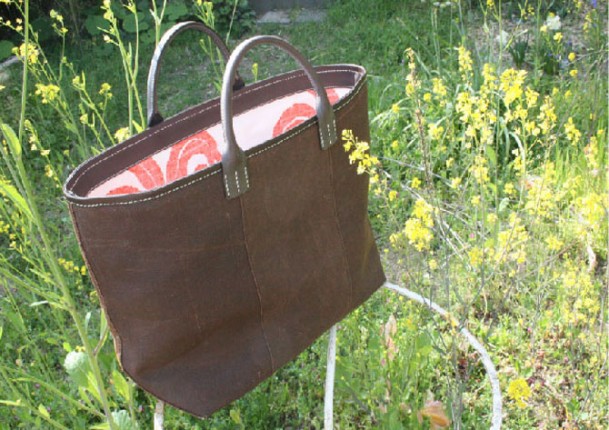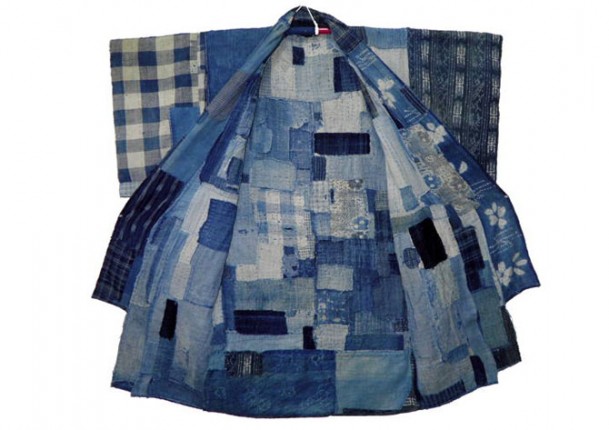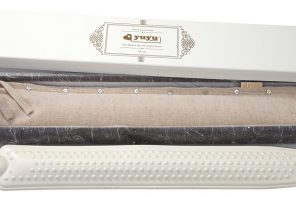
I’m still in ‘Japanese make do and mend’ mode (after Monday’s post on Kintsugi) and have another recycle-y word for you, Mottainai, which is Japanese for ‘waste not, want not’ or the beauty of respectful reuse of fabrics until they are completely spent (which is how the Japanese would say it).
Japan spent a long time cut off from the world when very little importing of any textile was done, so fabric was carefully recycled by patching and strengthening with embroidery to make it last as long as possible, which was known as mottainai. Just as our parents yelled at us to ‘waste not , want not’, so Japanese parents would hurl the same ‘mottainai!” verbal at their kids.
Much like here, Japan is now a buy-and-throw society, but there’s a growing movement to re visit these traditional techniques and a few artisan craftsmen are making new products using old ideas. My absolute favourite was the reusing of the cotton sakabukuro fabric bags used to strain and purify sake during production. The precious bags are patched up and cured (using the juice of persimmons) to make them last as long as possible, the really old ones end up looking and feeling like leather. You can buy the redundant sake bags on sites like Kimonoboy’s Textiles, (more on this below).
Retailer Naho Rokkoji, from the Hitomonokoto store in Japan, got his mate Takumi Kimura, a leather craftsman, to come up with a tote bag design (top photo) called Shib, made in the old sake bags, lined in antique fishing boat sails which you can buy online here, but really I think someone should tell Stella McCartney as they are crying out to be used in her non-leather range somewhere.

Vintage sake filtration bag, sakabukuro, on kimonoboy.com
Another lovely example of mottainai can be seen in old textiles that can be found if you search VERY hard in Japan. Because farm workers were poor, they patched and patched their bedlinen and work clothes (mostly indigo dyed) and then handed them down through families, creating the most exquisite examples of mottainai. It is not unusual to find examples of old jackets with fabric patches from the Edo period (1603-1867). There was a great exhibition of old futon covers, farm workers clothing and kimonos in Portland’s Japanese Garden if any of our US readers were lucky enough to visit (nice pictures of it here).

Vintage mottainai Japanese jacket on kimonoboy.com
Interested parties might like to know about a dangerously well stocked website called Kimonoboy Textiles, based in Fukuoka (they ship) which has some really wonderful mottainai examples of both the sake bags, futon covers and traditional Japanese workwear.
TEXTILE AND INDIGO GEEK KLAXON! Do NOT go on this site if you have difficulty resisting vintage textiles, just don’t, and for heavens sakes DON’T click on the button that say’s Tattered Treasures.
It’s patching, darning and quilting all the way for 2012 for me. Mottainai!

Mottainai vintage Futon bedlinen covers on Kimonoboy.com





This is fascinating and gorgeous stuff! I’m so glad you shared this with us. I’m excited to try and incorporate some of this in 2012. I’m already thinking of a pair of jeans one of my kids have ripped and how I can make this work with them.
Great post, what lovely heirlooms to pass down, and I love that bag, it looks like a worn leather tote.
Are you trying to bankrupt Kay?
I may have to inspect this myself. I shall hold you responsible.
M x x
gorgeous gorgeous gorgeous. where can I get persimmon juice!
I have to have one of those bags, both inside and outside are wonderful. Amazing weaves and prints contrasting with the patched and darned sake sack. I love it. Did you buy one Amanda? GG
Pleased you all like mottainai!, No GG I didn’t buy a bag as I had already bankrupted myself buying vintage kimono patchwork pieces and notebooks when in Japan….I am very tempted to buy something from Kimonoboy, but things are quite pricey…did everyone notice he has a SALE on from Monday 9th Jan?
Marv, appreciate @kaygardiner might have spending issues here, but did put the large warning sign in ‘specially for her! A
Beautiful. Can I recommend a book? Memories of Silk and Straw by Junichi Saga. The author was a Japanese MD. who, in early 60’s (?) interviewed elderly rural patients about life prior to WWII in their small villages. Each interview is 3-4 pages, and often features lots of detail about their parents occupation: futonmaker, indigo dyer, farmer, basket maker, etc. It is a wonderful book, especially for someone who appeciates craft.
Fabulous Dorothy, thanks for the tip, ‘heads straight to Amazon’…….A
I have a whole box full of ripped old jeans/denim offcuts which I had intended to put on freecycle next week (I’d been collecting them for a mason-dixon style rug)- no way can I do that now!
Your article made me proud ,and gave me energy to continue mu work.Thank you!!